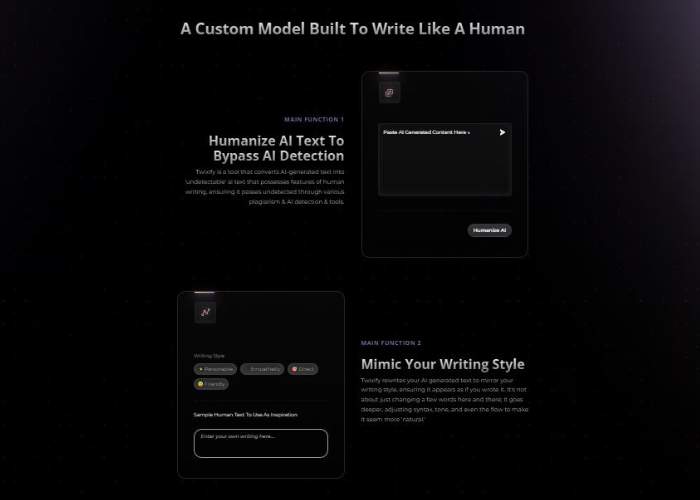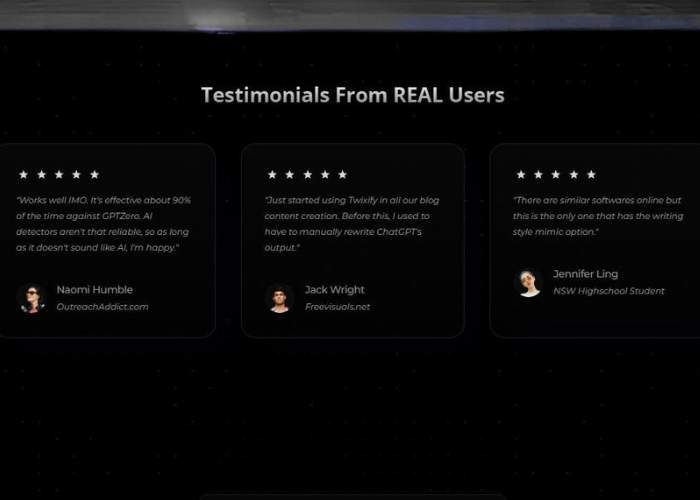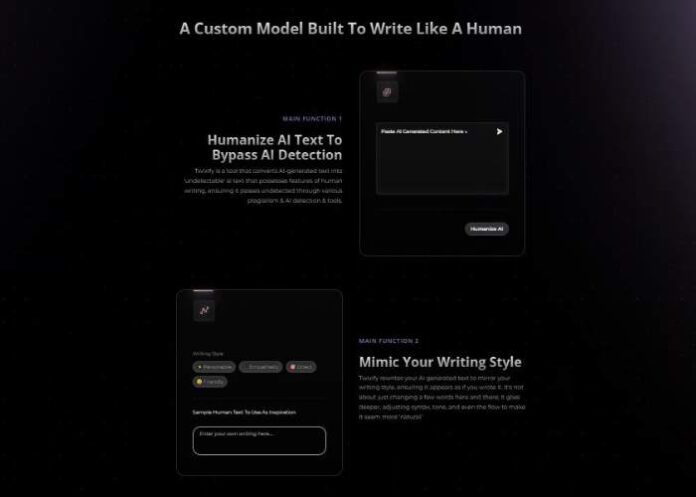Ever written something at 2 a.m. that’s so polished it feels like someone else must’ve typed it? Or maybe you’ve read a post online that made you think, “Yeah, no way a human actually wrote that.”
Lately, AI’s gotten good. Like, uncomfortably good. So naturally, a whole crop of tools have popped up claiming they can spot what’s machine-made and what’s genuinely human.
Today, I put Twixify.com to the test — one of the newer names in the world of AI detection.
And I’ll be honest… I didn’t expect much going in. The name kind of sounded like a candy bar start-up or a Twitter rebrand gone wrong. But spoiler alert: I was pleasantly surprised — and also slightly unnerved.
Let’s get into it.
What Is Twixify, and What’s It Trying to Do?
Twixify isn’t a rewriting tool. It’s not a chatbot or a content spinner. It’s an AI content detector, and it’s very clear about its job: spot AI-written content.
Specifically, it’s marketed as a tool for teachers, editors, recruiters, and journalists — aka people who want to know if what they’re reading is actually original or if someone asked ChatGPT to do their homework (or cover letter… or op-ed…).
You paste in text — or upload a file — and it runs it through its detection model. It then gives you a breakdown: is it likely human, likely AI, or somewhere in that awkward in-between zone where everything sounds suspicious?
But the real question is: does it work? More importantly — is it actually fair?
Because calling someone a cheater when they’re not? That’s a dangerous game.
How I Tested It (Read: Chaos, Curiosity, and Caffeine)
Okay, so here’s what I did. I ran several types of text through Twixify:
- Pure AI content from GPT-4 (default tone, no edits)
- Human-written articles from my blog and a few past clients
- Edited AI content — where I rewrote 30–40% in my own voice
- Personal text — emails, rants, even a love letter (yeah, I went there)
- Hybrid content — AI-generated outlines, human-written body
Then I cross-tested all of it with other tools — GPTZero, Originality.ai, Winston, etc. I wasn’t just looking for yes/no answers. I wanted to see how Twixify handled nuance, borderline cases, and stuff that fell into the gray zone.

Side-by-Side Scorecard
| Content Type | Twixify Verdict | Other Tools’ Verdict | Accuracy? |
| GPT-4 blog post | “Highly likely AI” | All agreed | ✅ Accurate |
| My handwritten essay | “Highly likely human” | All agreed | ✅ Accurate |
| Lightly edited AI piece | “Possibly AI” | Mixed results | ✅ Fair enough |
| Personal email to friend | “Likely human” | Some flagged it as AI | ✅ Refreshing |
| ChatGPT poem | “AI-written” | GPTZero flagged as human | ✅ Twixify wins |
| Satirical post (written by me) | “Possibly AI” | Most tools said human | ❌ Too cautious |
So… pretty good track record overall.
Twixify did a solid job flagging clean AI content, giving benefit of the doubt to conversational human writing, and (for the most part) staying honest when content was murky. It didn’t scream “AI” at every polished sentence, which — trust me — is more rare than it should be.
What Makes Twixify Different?
Here’s the part that got me.
Twixify’s detection model focuses on semantic patterns, syntactic repetition, and narrative rhythm — basically, how humans sound when they’re being human. That means it’s not just looking for AI “tells” like long compound sentences or passive voice.
It also detects:
- Tone flattening (AI’s habit of staying safe and neutral)
- Lack of emotional variance
- Predictable transitions (“Furthermore,” “In conclusion,” etc.)
- Overly consistent grammar and structure
Which makes sense, right? Real humans — especially ones in a hurry — write messily. We go off on tangents. We contradict ourselves. We have feelings.
Twixify gets that.
Features Overview
| Feature | Score (Out of 5) | Notes |
| Detection Accuracy | ⭐⭐⭐⭐☆ (4.5) | Strong, especially with obvious AI |
| UI & UX | ⭐⭐⭐⭐☆ (4.2) | Easy to use, but a little plain |
| Speed | ⭐⭐⭐⭐⭐ (5.0) | Fast results, even on longer text |
| Emotional Nuance Detection | ⭐⭐⭐⭐ (4.0) | Picks up tone & style reasonably well |
| False Positives Handling | ⭐⭐⭐☆ (3.5) | Slightly cautious with satire or punchy content |
| Transparency of Results | ⭐⭐⭐⭐ (4.0) | Gives confidence scores, not just verdicts |
| Free vs Paid | ⭐⭐⭐⭐☆ (4.3) | Free tier is generous; paid is fair |

What I Liked
- It doesn’t jump to conclusions. Some tools scream “AI” at anything with a comma. Twixify pauses, thinks, evaluates. Like a good editor.
- It’s emotionally aware. Not perfect, but it caught my conversational writing as human, even when it was typo-free. That’s rare.
- The confidence scores are a nice touch. Seeing a “74% chance this was AI” is way more helpful than a binary YES/NO.
- No login walls. You can use the tool without feeling like you’re being data-mined. At least upfront.
What I Didn’t Love
- It can be too careful. Some of my satirical or punchy writing got flagged as “possibly AI” just because I used symmetrical structure or repeated a phrase. Real writers do that on purpose, you know?
- It lacks feedback. I wish it gave reasons — like, “This sentence feels robotic because it lacks variation,” or “Too consistent tone.” Something. Anything.
- It doesn’t always play well with creative writing. Poetry, fiction, and expressive prose? Still kinda trips it up.
Who’s Twixify For?
Great fit for:
- Teachers checking student essays
- Editors reviewing content submissions
- Content managers trying to avoid AI bloat
- Journalists verifying source material
- Anyone with trust issues (hi, same)
Not ideal for:
- Creative writers submitting fiction or poetry
- People looking to “humanize” AI writing (it only detects, doesn’t rewrite)
- Writers seeking feedback on style/tone

Final Thoughts: More Than a Tool — A Gut Check
What struck me most wasn’t just that Twixify worked — it’s that it felt… respectful?
It didn’t just call my writing “too good to be human.” It understood that sometimes we write clearly. Sometimes we use big words. Sometimes we’re just in flow. And that doesn’t mean a machine wrote it.
Twixify doesn’t get it right all the time. But it gets it right more often than most. And that, in this current AI-content jungle, is something I’ll take any day.
Would I use it again?
Definitely. Especially when reviewing guest submissions or double-checking AI-heavy draft content before sending it off.
Would I trust it blindly?
No. But I wouldn’t trust any detector blindly — and that’s kind of the whole point.
But with a Table
| Category | Verdict |
| Accuracy | Very strong |
| Tone Awareness | Better than average |
| Speed | Lightning-fast |
| Creative Writing Handling | Needs work |
| Trust Factor | High, with some nuance |
| Best For | Editors, teachers, recruiters |
| Not For | Novelists, poets, or stylistic rebels |
| Overall Score | 4.4 / 5 |
In the End…
Twixify isn’t magic. It doesn’t read your soul. But it does have a decent ear for human rhythm, tone, and messiness. Which means it might just help us all preserve a little bit of what makes writing human in the first place — the flaws, the feelings, the stumbles.
And maybe that’s enough.
